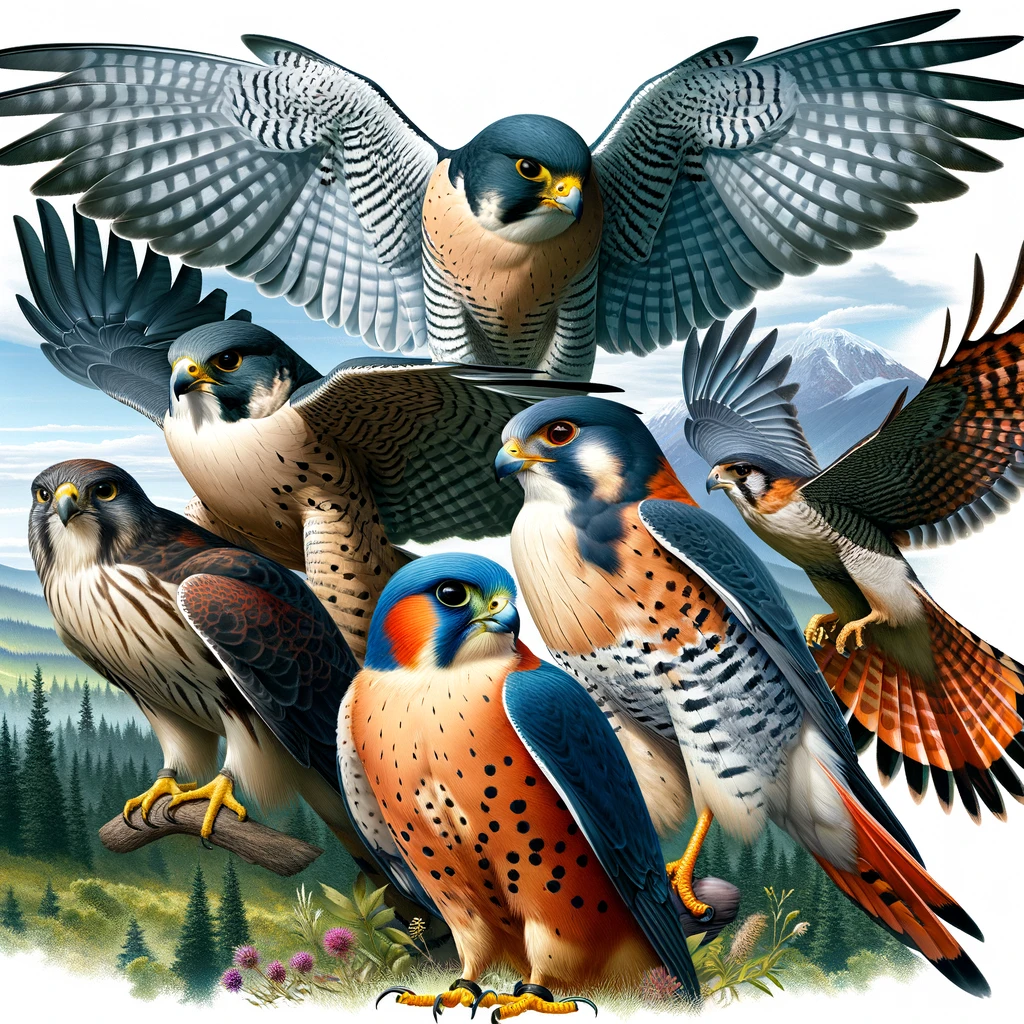
Encompassing diurnal birds of prey like falcons, caracaras, and allies, Falconiformes is a distinct order of small- to large-sized predators defined by sharp hooked beaks, strong grasping talons, and exceptional aerial agility facilitating hunting success. With over 300 species across 5 families, they possess nearly global distribution through the Americas, Europe, Asia, Africa, and Australia.
The early evolutionary origins of ancestral Falconiformes are likely traced back to owls in the Eocene epoch over 30 million years ago. From nocturnal forms, successive radiations yielded expert daytime hunters filling niche roles ranging from agile forest-dwelling specialists like the collared forest falcon to soaring upland red-throated caracaras adept at exploiting rodent irruptions across South American grasslands.
Today's diversity showcases particular concentration in Australasia and tropical regions globally. Sparrowhawks dash beneath dense canopies while peregrine falcons reach speeds over 320 km/hr during lethal stoops from vast heights. Specialized caracaras and falconets occupy tropical realms while gyrfalcons and others dominate Arctic skies. Wherever found, Falconiformes represent consummate aerial predators atop regional food chains thanks to merciless precision and physics-defying maneuverability that still thrills observers worldwide.
Characteristics
Physical Features
Falconiformes display a spectrum of sizes spanning tiny 12-centimeter pygmy falconets to huge 60-centimeter white-tailed sea eagles with 2-meter plus wingspans. Compact profiled forest dwellers contrast open country soaring forms. But all share adaptations granting feared predatory effectiveness.
Sharp hooked beaks easily puncture and tear flesh aided by notched tomial teeth on the upper mandible while protecting nares from counterattacks. Strong legs culminate in 3 frontward-facing toes each tipped with tapered sharp claws called talons used for striking and carrying prey through flight.
Plumage patterns vary from rufous hawk forms to slate gray goshawks hiding in plain sight amidst mixed woodlands before unleashing burst-speed ambushes from concealed perches. Some also utilize dual coloration with light feathers underneath and darker dorsal covers to capitalize on shifting illumination conditions throughout the day during flight.
Such refined features extend across diverse genera from typical falcons to caracaras and demonstrate endless specialization for maximizing aerodynamic hunting success central to worldwide dominance across habitats and altitudes by the order since antiquity.
Behavioral Traits
Employing a mix of still-hunting ambushes and more active aerial pursuits, Falconiformes surprise unsuspecting avian or mammalian prey with explosive bursts reaching incredible velocities. Hawks target smaller game with deft maneuvering whilst massive eagle talons snatch up hares and fawns. Chisel-tipped beaks efficiently dispatch and rend flesh from secured meals.
Migratory daily vertical movements cycle smaller forest falcons from nocturnal valley roosts toward hilltop updrafts. But lengthy seasonal migrations also transport high Arctic breeders southwards through temperate habitats by riding thermals and deftly adjusting specialist wing shapes granted by differential primary feather lengths.
Reproduction and Lifespan
Monogamous pairs establish cliff ledge eyries or tree platform nests to cradle broods. 2-4 speckled egg clutches receive attentive incubation up to 35 days before hatching. Fledging journeys push 10-12 weeks on average. Maximum falcon longevity may approach 15 years for prolific breeders like peregrine falcons but large tropical morphs possibly reach 20 years.
Some Extant Families
Falconidae (falcons and caracaras)
The widespread family Falconidae includes true falcons, kestrels, and caracaras across over 60 species. With peak diversity in Africa and South America, they occupy habitats worldwide from tundra to rainforest canopies. Shared traits facilitating ruthless hunting tactics unite them such as aerodynamic profiles, sharply hooked beaks, formidable talons, and variable speed flight control.
Accipitridae (hawks, eagles, kites)
The expansive Accipitridae family encompasses most diurnal birds of prey including hawks, kites, eagles, buzzards, and Old World vultures. Over 240 species demonstrate spectacular hunting adaptations paralleling Falconiformes radiation across forests, grasslands, and wetlands globally. For example, the crowned hawk-eagle shares deep woodland niches with smaller goshawks exploiting agile maneuverability and burst-speed flight to overwhelm arboreal prey through the canopy.
Convergent hunting strategy parallels across families support competitive exclusion principles but some genera partition vertical niche space to minimize conflict potential. Thereby two lineages flourish in similar fashions across continents.
Global Distribution and Habitat
across every continent except Antarctica thanks chiefly to immense vagility granting range flexibility as consummate fliers. Forest and open country forms reach peak diversity at lower latitudes but migrate vast distances when seasonal shifts encourage movement.
Forest and woodland falcons occupy tropical jungles and temperate mixed stands worldwide thanks to dense vegetation and canopy structures supporting abundant avian prey like songbirds, pigeons, woodpeckers, and game birds. The thick cover also shelters concealed nest sites located high on escarpments or towering trees.
More open terrain suits agile caracaras adept at exploiting rodent outbreaks across scrublands, grasslands, and ranchlands of Central/South America, Africa, and Asia well-adapted towards scavenging carrion between scarce mammal eruptions. And ubiquitous common kestrels thrive across ecotones ranging from parklands to deserts.
Such habitat flexibility relies on aerodynamic adaptability and sharp feeding tools facilitating capturing prey wherever sufficiently abundant. Broad wings permit soaring over vast open terrain while long tail streamers increase maneuverability darting through dense forests. Hooked beaks readily penetrate fleet avian targets or swift rabbit kits and fawns. Thereby Falconiformes discovered diverse homes through ruthless mastery of aerial ambush hunting worldwide.
Ecological Importance
As apex predators, Falconiformes play irreplaceable roles in regulating prey populations that might otherwise irrupt destructively without natural control. Forest falcons cull birds, tree squirrels, and lemurs that could defoliate trees during high-density episodes. Caracaras help expand rodent numbers across South American ranges preventing crop loss. Thereby they enhance stability preventing boom-bust prey cycles from disrupting ecosystems.
Selectively targeting weaker individuals also strengthens prey gene pools - as only the most alert and swift victims escape stooping talons. Thereby prey continually hone vigilant instincts and flight performance through evolutionary time against raptor pressures. Abundant raptors support secondary scavenging opportunities for facultative vultures.
Furthermore, as wide-ranging hunters integrate habitats vertically, resilient falcon populations indicate intact environments featuring sufficient sheltered nest sites and available food flows to nourish the next generation. Dramatic declines in nesting pairs signal issues with pesticides, pollution, habitat loss, or other ecosystem threats requiring urgent evaluation and intervention before deterioration spreads more widely across constituent communities.
Thereby falcon sentinels safeguard balanced biodiversity beyond sheer predatory contributions - making them increasingly essential barometers for managing sustainable habitats aligned with raptor preservation through future uncertainty.
Falconiformes in Nepal
Nepal’s vast forest and mountain terrain sustain impressive Falconiformes diversity - from tiny 20-centimeter collared falconets to giant mountain hawk-eagles with 2-meter wingspans. Over 30 species occupy various habitats ranging from lowland Churia rainforest to the alpine meadows decorating Himalayan peaks exceeding 7,000 meters in height.
Dense middle hill woodlands support oriental goshawks and besra sparrowhawks that ambush unwary jungle fowl beneath the canopy. Peregrine falcons and lammergeiers cruise foothill valleys. The staggering Himalayan golden eagle surveils expansive ridges using expert updrafts to lift massive frames with minimal effort.
While most species remain common across suitable habitats, degradation of lowland forests and high-elevation grasslands poses eventual risks for waterfowl and upland gamebird populations these aerial hunters depend upon through the winter and summer seasons respectively.
Culturally the regal Himalayan griffon and golden eagle grace Tibetan Buddhist motifs as esteemed messengers. Religious kite-flying celebrations nationwide temporarily shift perceptions toward the formidable predators circling overhead. There and elsewhere they command awe reserved for elite fliers.
Conservation Challenges and Efforts
While most falcon species remain abundant in suitable habitats thanks to high mobility pathways, increasing pressures have pushed over 25 species onto threatened or near threatened conservation status including endangered Philippine eagles struggling with deforestation. As apex predators, falcons serve as important environmental health barometers.
Habitat pressures including development, logging, and agricultural land conversion jeopardizes shelter and prey for specialized endemics with restricted ranges, while also reducing biodiversity integrity for migratory and dispersing forms navigating patchy bisected landscapes seasonally. Secondary poisoning from pesticide-laden prey and lead bullets also threaten survivorship.
However, dedicated raptor conservation measures gained momentum to stabilize populations through active interventions like captive breeding and reintroduction initiatives that helped restore aplomado falcons in the Southwestern USA. Community-focused breeder incentive programs increase localized tolerance protecting essential cliffside eyries and forest nest stands. Laws aimed at reducing secondary rodenticide concentrate and lead ammunition threats have made progress across 30 countries so far.
While vigilance remains vital for vulnerable species persisting through compounding changes, concerted conservation networks focused on Umbrella protector species like the familiar peregrine promise collateral stability radiating across constituent communities sharing increasingly precarious global habitats.
Conclusion
Falconiformes' tremendous vagility unlocking global distribution would mean little without supreme mastery over maneuverability and speed-channeling aerial capabilities for ruthless hunting efficiency that allowed falcons to help regulate populations from seabird colonies to mountain forests over eons of shifting continental rearrangements.
Thereby the order upholds ecosystem integrity across habitats permitting their unmatched success as pursuit fliers. In turn, monitoring breeding densities provides managers easy visibility into habitat stability and food chain structure needing protection to perpetuate sustainable falcon presence through uncertainty ahead.
In Nepal, continuity for seasons showcasing the full spectrum of Falconiformes stratifying vertical space promises balanced oversight monitoring prey populations across altitudes if increased pressures from traditional herding practices, religious harvests, deforestation, and climate disruption all align to sustain intact seasonal ranges critical for upholding niche viability into the future.
Fortunately, concentrated efforts through community nest wardens assisted by prefectural agencies promise to nurture precious Falconiformes diversity both cherished and feared by Nepali communities beneath the vast skies they share through coming generations if habitat connectivity receives sufficient vision moving forwards against encroaching worldwide development trends.

